How to Slice and Dice an Onion
A safer way to dice for accident-prone or less experienced cooks.
In the mood for some chili? You're gonna need three cups of onion, medium dice. Making chicken stock? Two onions in large chunks, please. And what about onion soup? Yes, believe it or not, you'll need onions for that, too.
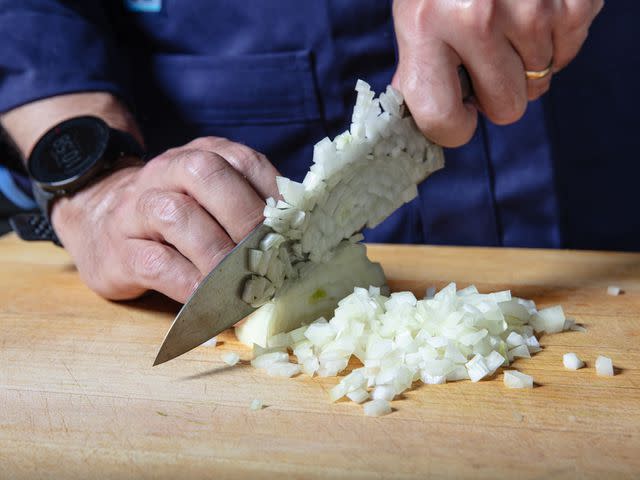
Serious Eats / Amanda Suarez
No matter how you slice 'em, I'd estimate that onions are used in a good 30 to 40% of any cook's savory-dish repertoire, if not more. They are the first thing you should learn how to cut when you pick up a knife, and, at least for me, still one of the most pleasurable foods to take a sharp blade to.
In this video and guide, I'll show you the two basic onion cuts—the dice and the slice—and talk a little bit about the flavor and cooking differences you can expect from them.
How to Dice Onions Traditionally
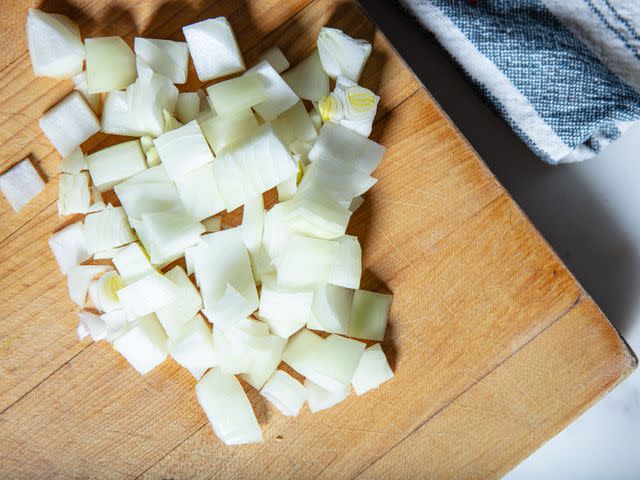
Serious Eats / Amanda Suarez
Large, three-quarter-inch-plus dice are used to flavor soups and stocks and will typically be strained out and discarded after their flavor has been extracted through simmering. Large dice can also be used for skewering and grilling, or occasionally for stir-fries or dishes in which they will be further chopped or blended after cooking. Medium (half-inch) dice are commonly used for hearty stews, soups, braises, or sauces, while small (quarter-inch) dice are used in smoother, more refined sauces, stews, curries, or braises; in meat recipes, like meatballs or meatloaf; and in raw preparations, like salsas and some salads. When cooked for a long time, they'll melt into a sauce.
Dice smaller than that are called brunoise and are not commonly used in home-cooked dishes. You might see them in fancy restaurant dishes, like beef tartare or some pâtés.
Step 1: Trim the Stem End
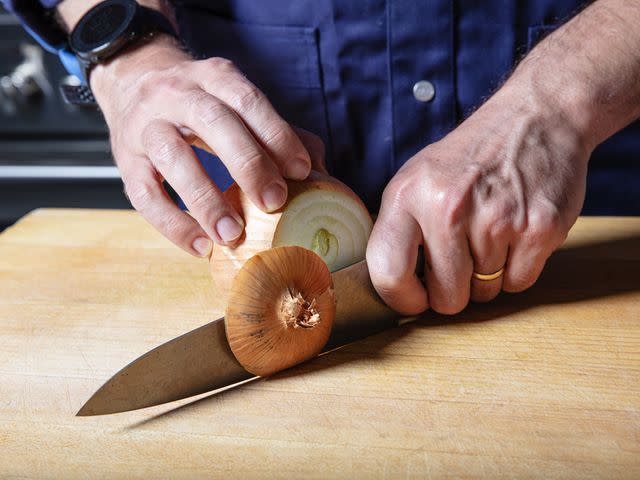
Serious Eats / Amanda Suarez
Hold the onion steady with your non-knife hand, and trim off the stem end by about a half inch.
Step 2: Slice in Half
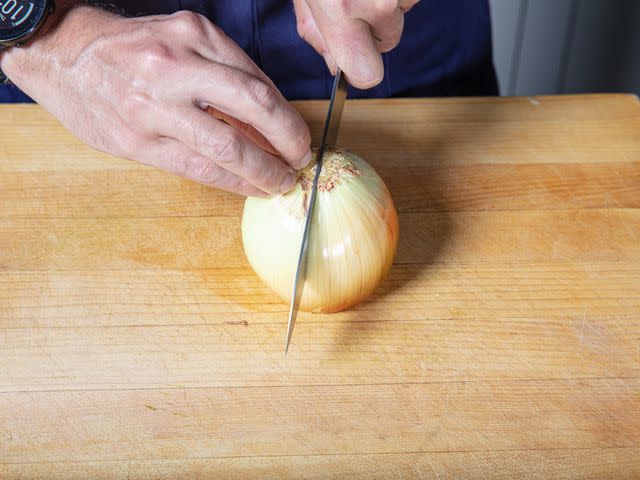
Serious Eats / Amanda Suarez
Lay the onion flat on its cut surface and slice it in half, using your non-knife hand to hold it steady.
Step 3: Peel Off the Outer Layer
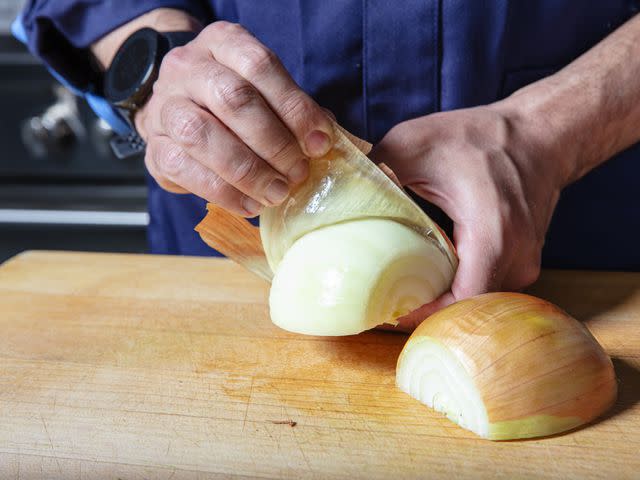
Serious Eats / Amanda Suarez
Peel off the remaining skin. The first pale layer underneath the skin can often be dry and tough, so it's a good idea to remove the outermost layer as well to reveal the more tender flesh underneath.
Step 4: Cut Along the Z-Axis
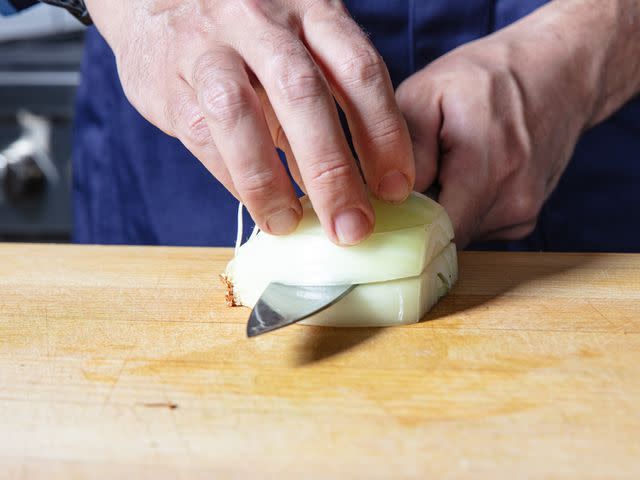
Serious Eats / Amanda Suarez
Lay the onion flat, and make a series of horizontal slices, holding the top of the onion steady with the tips of your fingers. Slice nearly all the way through, but keep the root end intact so that the layers remain connected.
Keeping the onion close to the edge of the board in order to give your knife hand clearance will facilitate this process. (Whether you make these cuts or the cuts in step 5 first is a matter of personal preference. Do what feels most comfortable to you.)
Step 5: Cut Along the Y-Axis
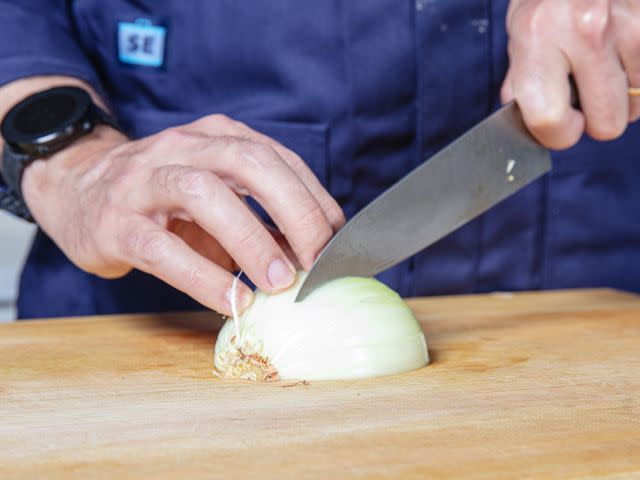
Serious Eats / Amanda Suarez
Make a series of vertical cuts with the same spacing as your horizontal cuts, again keeping the root end intact. To hold the onion, curl back the tips of the fingers on your non-knife hand, keeping your thumb behind them in order to prevent accidentally cutting your fingertips or thumb. Hold the knife blade directly against your knuckles to guide your strokes.
Step 6: Cut Along the X-Axis
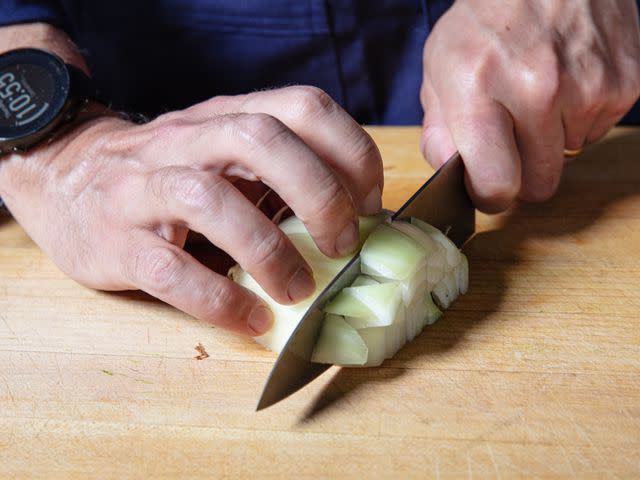
Serious Eats / Amanda Suarez
Finally, dice the onion by making a series of vertical cuts perpendicular to the ones you just made, again using the knuckles of your non-knife hand as a guide for the blade. As you get toward the root end, you can rotate the onion 90 degrees forward, so that the most stable side is facing down, and continue slicing until just the root remains.
Step 7: Transferring Dice
Do not use your knife blade to pick up chopped vegetables—rubbing it against the cutting board will quickly dull its edge. Instead, use a bench scraper, which is custom-designed for the task.
Fine and Medium Dice
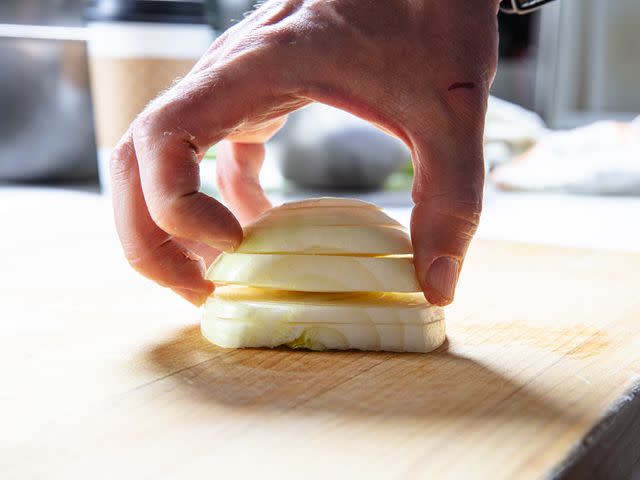
Serious Eats / Amanda Suarez
The spacing of your horizontal and vertical cuts determines the size of your final dice. For large dice, make cuts three-quarters of an inch to one inch apart. For medium, about half an inch apart. For fine dice, make cuts a quarter inch apart or smaller, and for brunoise, cut as finely as possible—a very sharp knife and a steady hand should have no problem with eighth-inch or even sixteenth-inch cuts.
The Safer Way to Dice Onions
All cooks have, at some point, nicked themselves with a knife in the kitchen—it happens. We can accept that accidents are a fact of life, while still doing our best to minimize risk of injury when carrying out knife-heavy prep work. There are the usual culprits for cuts in the kitchen that can be easily addressed: dangerous dull knives can be sharpened, improper hand placement can be corrected, irregularly shaped ingredients can be turned into stable flat surfaces, wobbly cutting boards can be secured, and simply paying attention to the task at hand goes a long way to preventing trips to the emergency room (I can chalk up most of my kitchen injuries to rushing through a task while distracted).
One other easy way to lower the odds of cutting yourself is to avoid knife strokes that don't end with the sharp edge of your blade meeting a cutting board. Horizontal or angled knife cuts that bring the blade towards your non-dominant hand and/or body are inherently more dangerous than vertical cuts coming down on a board. A slip of the hand, or a slippery ingredient, can send you scrambling for the first aid kit. Along with failed avocado pit extractions, the horizontal knife cuts that are employed for the classic onion dicing technique are one of the most common causes of injury in the kitchen. But luckily for all of us that are prone to fluke injuries, there's an easy, safer way to dice onions that eliminates those pesky parallel-to-the-cutting-board knife strokes. Here's how to do it.
Step 1: Cut Onion Into Quarters Through Root End
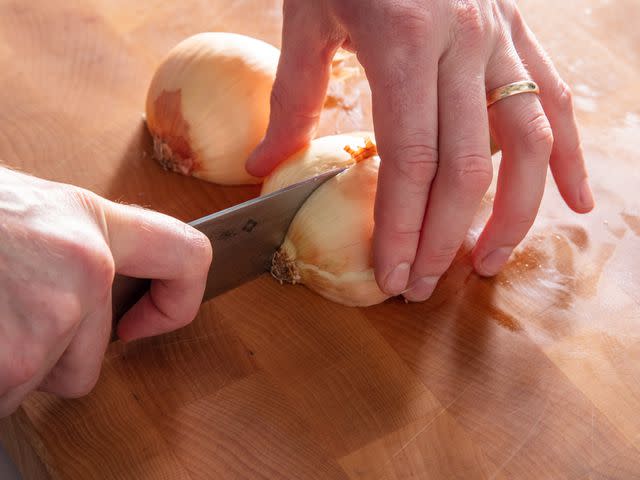
Serious Eats
Start in the same way as you would for a traditional dice: Trim off the stem end, and halve the onion through the root end. Lay the onion halves flat on their cut sides and, working one at a time, once again slice them in half through the root end, leaving you with four pieces.
Step 2: Peel Off the Outer Layer
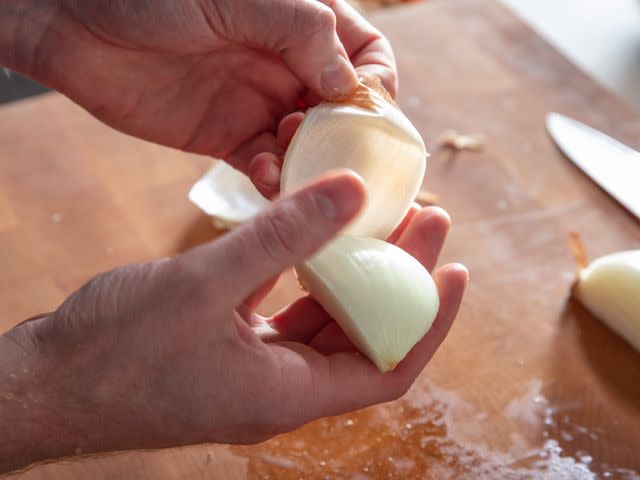
Serious Eats
As with the regular dice, peel off the skin and papery dry pale layer underneath from each onion quarter.
Step 3: Make First Set of Vertical Cuts on Y-Axis
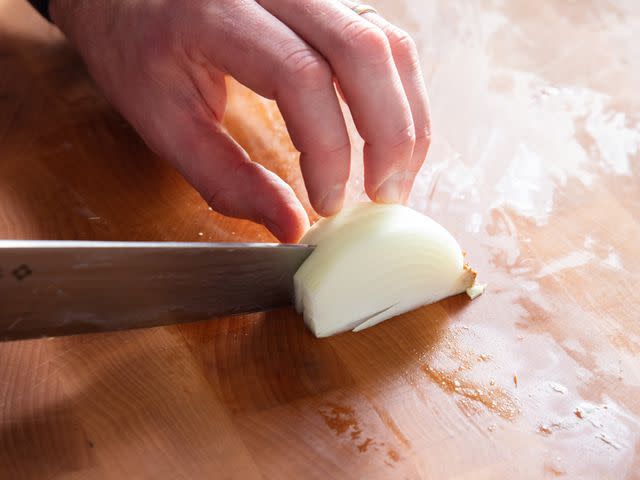
Serious Eats
Working with one quarter at a time, make a series of evenly spaced vertical cuts, keeping the root end attached. Use the same claw grip technique for your non-dominant hand, using your knuckles to guide the knife strokes.
Step 4: Flip 90 Degrees Onto Other Flat Side
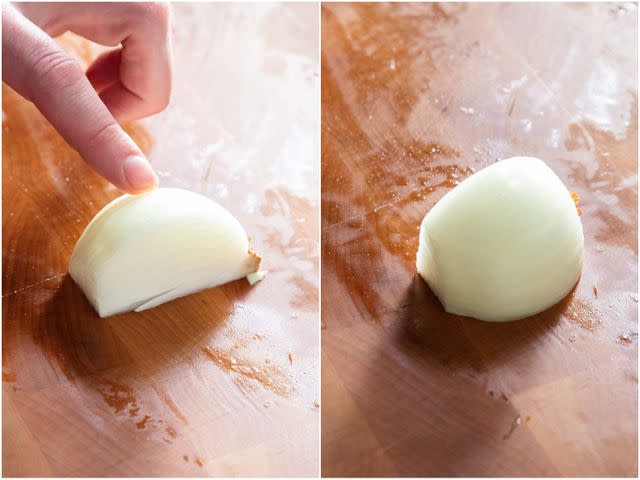
Serious Eats
Flip the onion quarter onto its second flat side, thus rotating it 90 degrees. The vertical cuts that you just made will now be running horizontally along what is now the X-axis.
Step 5: Make Second Set of Vertical Cuts on New Y-Axis
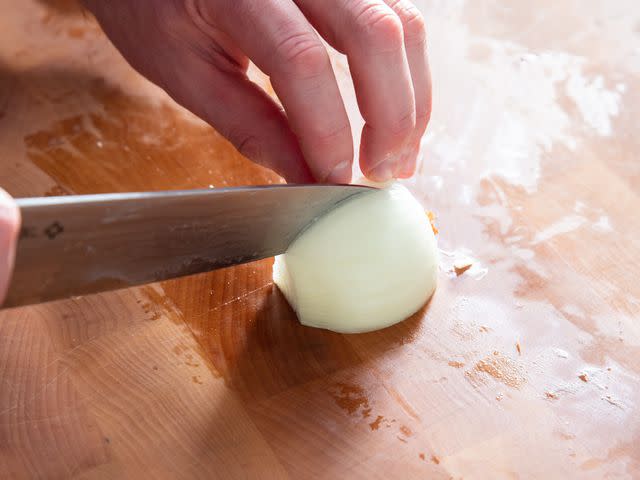
Serious Eats
Now make a series of vertical cuts on the newly formed Y-axis with the same spacing as the first set, once again keeping the root end attached.
Step 6: Finish Dice by Cutting Along X-Axis
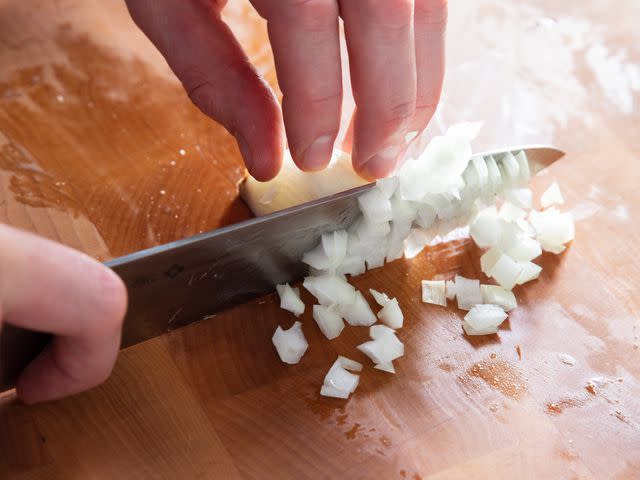
Serious Eats
Finish the process by making a series of evenly spaced vertical cuts perpendicular to the ones you just made, once again using the knuckles on your non-dominant hand to guide the last set of knife strokes. Gaze upon your perfect dice, produced without making any horizontal cuts to your onion or non-knife hand.
How to Slice Onions
Imagine the onion as a globe, with the stem end at the north pole and the root end at the south. The direction in which you slice your onions can have a huge impact on both flavor and texture. See, onion cells are not symmetrical, and slicing from pole to pole will actually rupture fewer cells than slicing parallel to the equator. Because the pungent aroma we associate with onions does not actually arise until cells are ruptured, slicing pole to pole produces milder, sweeter-tasting slices.
Here's a simple experiment: Slice one half of a single onion pole to pole and the other half parallel to the equator. Place both sliced halves in sealed containers, and let them rest for 15 minutes. Now open those containers and smell them. You'll probably find that the onion sliced pole to pole has a milder flavor. That carries over into your food!
There are also textural differences. Onions sliced parallel to the equator are rarely used in cooked applications, as they have an uneven texture that can turn wormy or stringy when cooked. They're limited mostly to raw applications in which a pungent flavor is desired, like salads or sandwiches, or dishes specifically requiring a round shape, like onion rings.
When a recipe calls for sliced onions, pole-to-pole slices are what we're looking for. They cook more evenly, tenderize better, and, when cooked long enough, will almost completely break down, adding body to soups, stews, and braises.
Cutting Rings and Half Rings
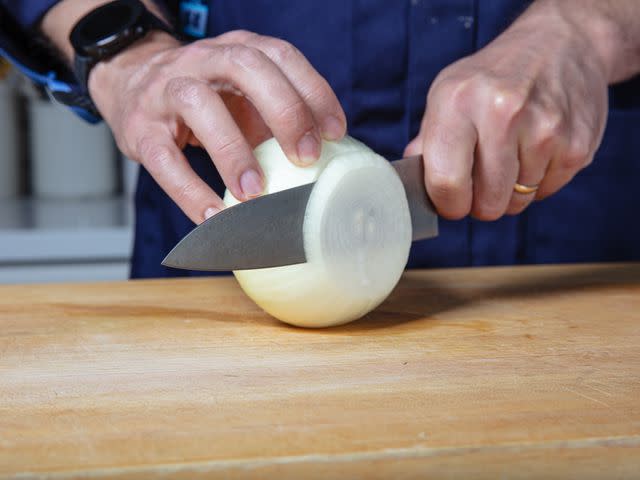
Serious Eats / Amanda Suarez
To cut onion rings or half rings, simply peel the onion as for dicing, then cut parallel to the equator, using your knuckles as a guide. If cutting a whole onion, hold it in your fingertips to keep it stable.
To Slice for Cooking, Step 1: Trim Root End
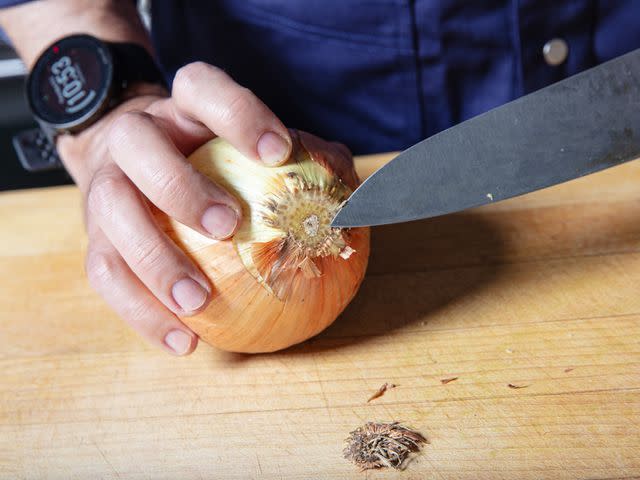
Serious Eats / Amanda Suarez
After trimming off the stem end and halving the onion, as for dice, turn the onion around and trim off the root end as well before peeling the whole thing.
To Slice for Cooking, Step 2: Slice
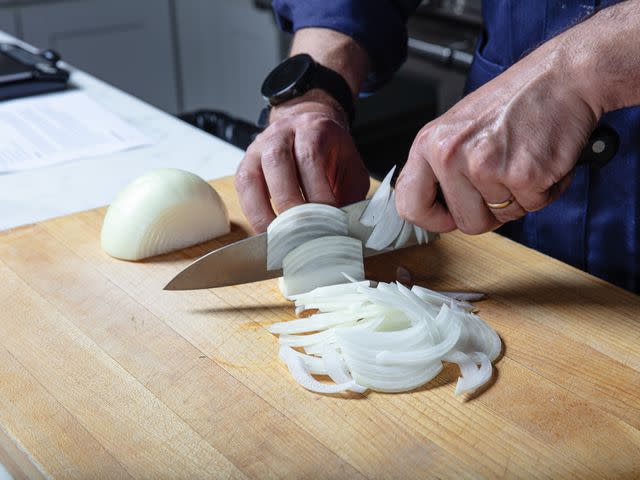
Serious Eats / Amanda Suarez
Make a series of slices perpendicular to the equator of the onion (pole to pole), once again using the knuckles of your non-knife hand as a guide.
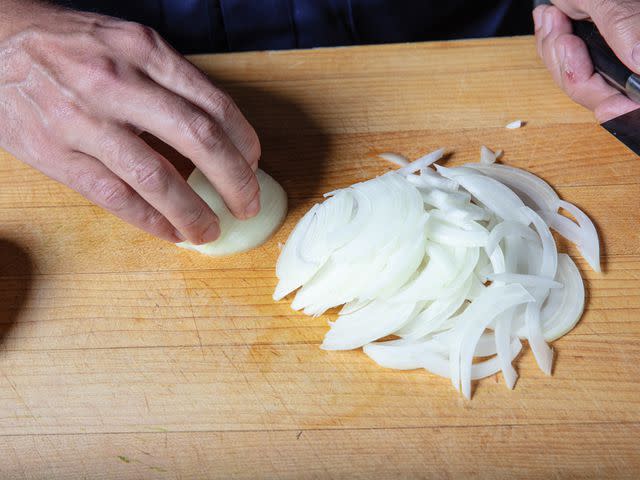
Serious Eats / Amanda Suarez
Pro Tips: Making the Most of Your Onions
If you're working with a large volume of onions, to maximize efficiency, work by taking every onion through one step before proceeding to the next step. In other words, peel all of your onions before you start making horizontal slices in any of them. Similarly, make all of your horizontal cuts before making your vertical cuts. It will keep your work space more organized, require fewer trips to the compost bin, and make you look like a pro.
If you want to serve your onions raw and remove as much of their pungency as possible, put them in a strainer and rinse them under hot running water. Hot water is more effective at washing away lacrimators (the chemicals responsible for causing us to tear up when slicing onions) and will not soften the onions. Also, don't let onions sit for long after slicing: They'll get more and more pungent as they rest.
As for onion tears, there are a lot of home remedies that purport to solve the problem. Chewing gum. Placing a candle or a slice of bread nearby. Chilling the onion. Most of them don't work very well. The only real solution is to protect your eyes. If you wear contact lenses, you're in luck; they should help! If not, an inexpensive pair of goggles will keep the tears away. At the very least, a fan blowing the chemicals away from you should fend off some of them. (Also, it helps to realize that onions don't feel pain, and there's nothing to cry about.)
Not sure what onions you should be buying for what purpose? Never fear; check out our Beginner's Guide to Onions for a detailed look at the differences between onion types and how to make the most of them.
Editor's Note
This post from J. Kenji López-Alt has been updated with an additional section ("A Safer Way to Dice Onions") from Sasha Marx.
November 2016
Read the original article on Serious Eats.

